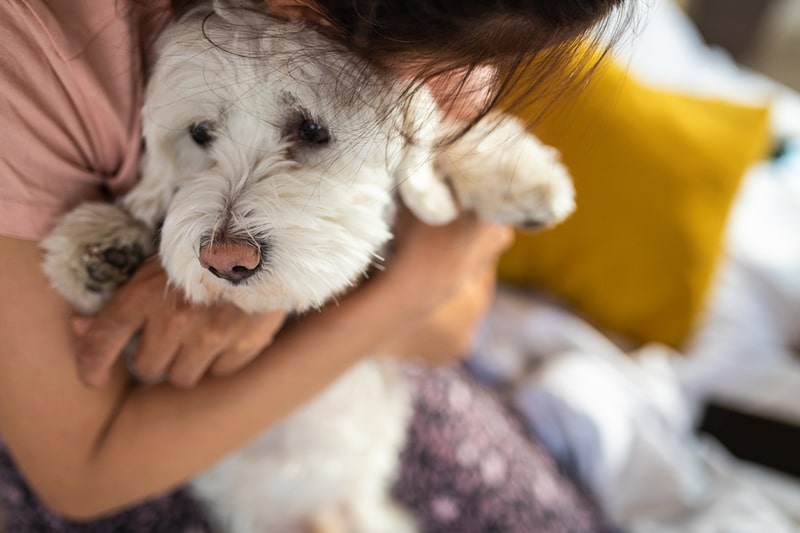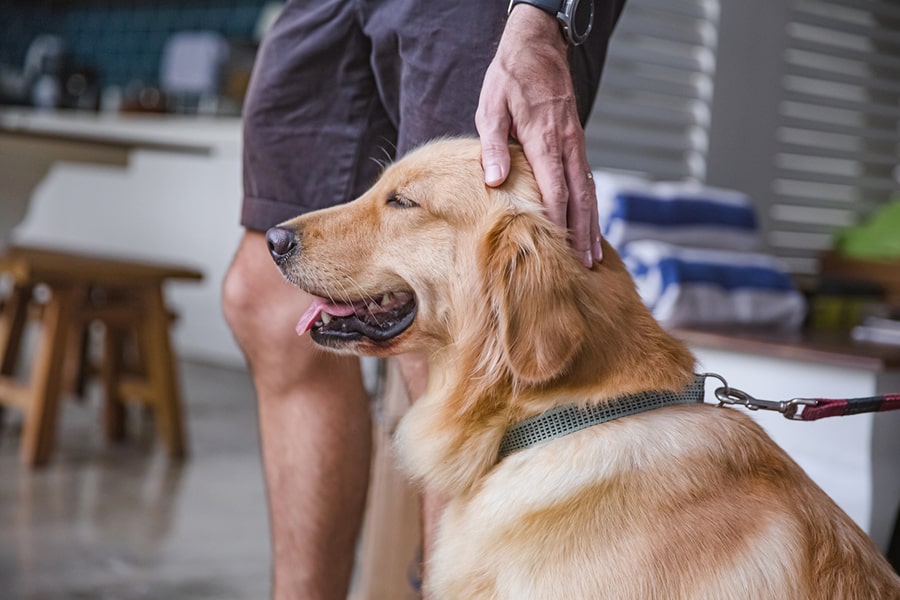
It can be heartbreaking to see your dog acting depressed or anxious. Find out how you can help your pooch with mental health issues that don’t just affect humans.
3 Common Dog Mental Health Issues
Dogs can show symptoms of anxiety and depression, which can go hand in hand. They can also develop compulsive behaviors when they’re struggling with these mental health issues.
Anxiety
Like many of us, dogs are creatures of habit, and they can become anxious when their routines are disrupted. They can also suffer from separation anxiety or feel anxious after a traumatic experience, such as getting injured in a fight with another dog. Symptoms of anxiety in dogs can include:
- Avoiding eye contact
- Excessively licking their lips or sniffing the air
- Moving away from people who approach them
- Yawning when they’re not tired
- Pacing back and forth or in circles
- Trembling
- Whimpering or whining
- Yawning when they’re not sleepy
Anxious dogs can also appear restless and have a hard time settling down. Additionally, you may notice changes in their eating or drinking habits.
Depression
Can dogs get depressed? That’s a good question that doesn’t have a simple answer. We can’t really know what goes on in their minds to equate it with human depression. However, we do know they can experience deep sadness and show signs of depression similar to people such as:
- Appetite loss
- Lethargy
- Inability to sleep or sleeping more than usual
- Withdrawal from social interaction
Depression in dogs is usually temporary and often comes in response to a major life change, such as moving to a new home. It will often resolve itself as the dog acclimates to their situation.

Compulsive Behaviors
Dogs aren’t diagnosed with obsessive-compulsive disorder (OCD) like humans. We don’t know if they have obsessive thoughts, which is a hallmark of this illness for humans. However, anxiety, fear, boredom, frustration, and other negative emotions can lead to compulsive behaviors.
These behaviors are exaggerations of normal dog activities, which are done for longer periods of time and repeated in situations where they wouldn’t be expected. For instance, you wouldn’t bat an eye if your dog was licking their paw after it was hurt, but constantly licking an uninjured paw may indicate a compulsive behavior. Behaviors that can become compulsive include:
- Barking
- Chewing
- Excessive licking
- Pacing
- Snapping at the air
- Spinning
- Sucking on toys
- Tail chasing
Compulsive behaviors can start out as a way for dogs to soothe themselves. They become problematic when dogs ritualize the behavior. For example, a dog might suck on a favorite toy when they’re afraid during a storm. Because this made them feel better, they may begin to search out the toy and repeat the behavior anytime they are scared or anxious.
Some obsessive behaviors can be harmful to dogs. Dogs who lick their sides constantly can cause painful injuries or skin infections. Sucking on objects can result in choking or swallowing small pieces, which can obstruct the intestines. Dogs have also been known to chase and attack their tails, damaging them so badly that amputation is needed.
Dogs with mental health issues can also exhibit behavior problems, such as aggression, excessive barking, or destructive chewing. These unwanted behaviors can be disruptive and even dangerous. They may require help from your veterinarian or a certified expert in dog behavior or training.

Causes
Dog mental health issues are often in reaction to a life change. Some dogs can be quite sensitive, and they may experience depression or anxiety over what seem to us like little things, such as a new leash or dog carrier. More significant events that can affect our dog’s mental health include:
- An addition to the household, such as a new baby, adopted child, spouse, roommate, or pet
- Someone leaving the home, for instance, a child going away to college, a spouse moving out after a divorce, or the death of a family member or pet
- Moving to a different home or apartment
- Shifts in routine due to children going back to school or a job change
In addition, dogs may show signs of mental health issues after something traumatic happens, like getting hit by a car or experiencing a disaster, like a hurricane or house fire. It’s also important to keep in mind that symptoms of depression and anxiety can be signs of illnesses, which need to be diagnosed and treated by a veterinarian.
Dogs at Risk for Mental Health Issues
Any dog can suffer from mental health issues, but it is a common and heartbreaking problem for dogs who have been neglected, mistreated, or abused. Anxiety can also be more prevalent in smaller breeds, such as Chihuahuas, Shih-Tzu, and Jack Russell Terriers.

When to Call the Veterinarian
If you’re concerned about your dog’s mental health, you should reach out to your veterinarian to help address your dog’s suffering sooner than later. Issues like compulsive behavior can also be easier to treat when they’re addressed before the behavior becomes too ingrained. Early treatment can also prevent injuries from compulsive behaviors and avoid disruption to your household, which can be stressful for everyone in the home.
Treatment
Treatment will depend on the nature and severity of the problem. It can include:
- Lifestyle adjustments: In some cases, you may be able to identify triggers that make your dog stressed or anxious and modify their environment or routine to avoid them. You can also look into products designed to address dog anxiety, such as weighted blankets or thunder jackets.
- Desensitization: This involves taking gradual steps to help your dog grow comfortable with something that is upsetting them. For instance, if your dog is anxious meeting new people, you would start by gently introducing them to one person in a safe and controlled environment.
- Behavior modification: The goal of behavior modification is to change the way your dog reacts to people, situations, or particular things. It’s best to connect with an expert in this technique to make sure it’s done properly.
- Medication: Your veterinarian may recommend anti-anxiety medication to help your dog cope in the short-term.
Are There Dog Psychologists?
You may find people who call themselves doggie therapists or other kinds of dog mental health experts, but you should always talk to your veterinarian first. They have extensive training and experience dealing with dog mental health and behavioral issues.
Depending on the severity of the condition, your veterinarian may refer you to a specially-trained veterinarian in animal behavior, who will be able to help you and your pet through these challenges. If you decide to consult with another type of expert, be sure to check their credentials and references.
Your veterinarian may also recommend a Certified Applied Animal Behaviorists (CAAB) or Associate Certified Applied Animal Behaviorists (CAAB) to help your dog. These experts have earned an M.S., M.A., or Ph.D. degree in animal behavior and are trained in behavior modification techniques.

Tips to Avoid Dog Mental Health Issues
Taking care of your dog’s mental health is part of being a responsible dog parent. Here are some ways to help your dog avoid issues like anxiety or depression:
- Maintain a routine. Of course, there will be days when you can’t feed or walk your dog at the usual time, but having a good routine can help your dog feel comfortable and confident.
- Avoid stressors if possible. For instance, if your dog is anxious around new people, take walks on less populated routes and make slow introductions when you meet a stranger.
- Leave the TV or radio on. If your dog gets lonely when you’re out of the house, consider putting on a soothing TV or radio station. Animal and nature channels work great for some dogs!
- Use positive reinforcement. Scolding or yelling at your dog can create stress and anxiety. It’s healthier to reward them for being good rather than punishing them for bad behavior.
- Take great care of them. Help them stay in shape mentally by making sure they’re in shape physically. That means feeding them a nutritious diet, making sure they are getting plenty of sleep, giving them enough opportunities to exercise, and offering them engaging toys. Puzzle toys, in particular, can help keep your dog mentally sharp and prevent boredom.
- Play with them. Playtime can be a great stress reliever. It also strengthens the bond you share with your dog, which can make you both feel loved and happy.
- Know your dog’s personality. Some dogs need a little space, while others prefer extra attention when they feel stressed or anxious. If you know how your dog likes to process their feelings, you’ll be better equipped to give them what they need.
- Consider your own emotional state. According to research, dogs can understand our emotions. So, your dog may be feeling blue because they sense you’re sad or depressed. They may be giving you a clue that you need some self-care.
And of course, never forgot to give your dog lots of love each and every day!
The information presented in this article is for educational and informational purposes only and does not constitute or substitute for the advice of your veterinarian.
(opens new window)
Helpful resources for pet parents
Browse categories
-

DIY Pet Projects
Get some inspiration for DIY pet projects, from homemade dog and cat treats to toys, doghouses, and cat towers.
-

Fun Facts About Himalayan Cats
Some may joke Himmies are just Persians in a Siamese costume, but we know how uniquely special they truly are.
-

Dogs and Panting
What does it mean when a dog is panting? Read about what could cause the heavy breathing, when it’s something to worry about, and how to calm a panting dog.

Browse Categories
(opens new window)
